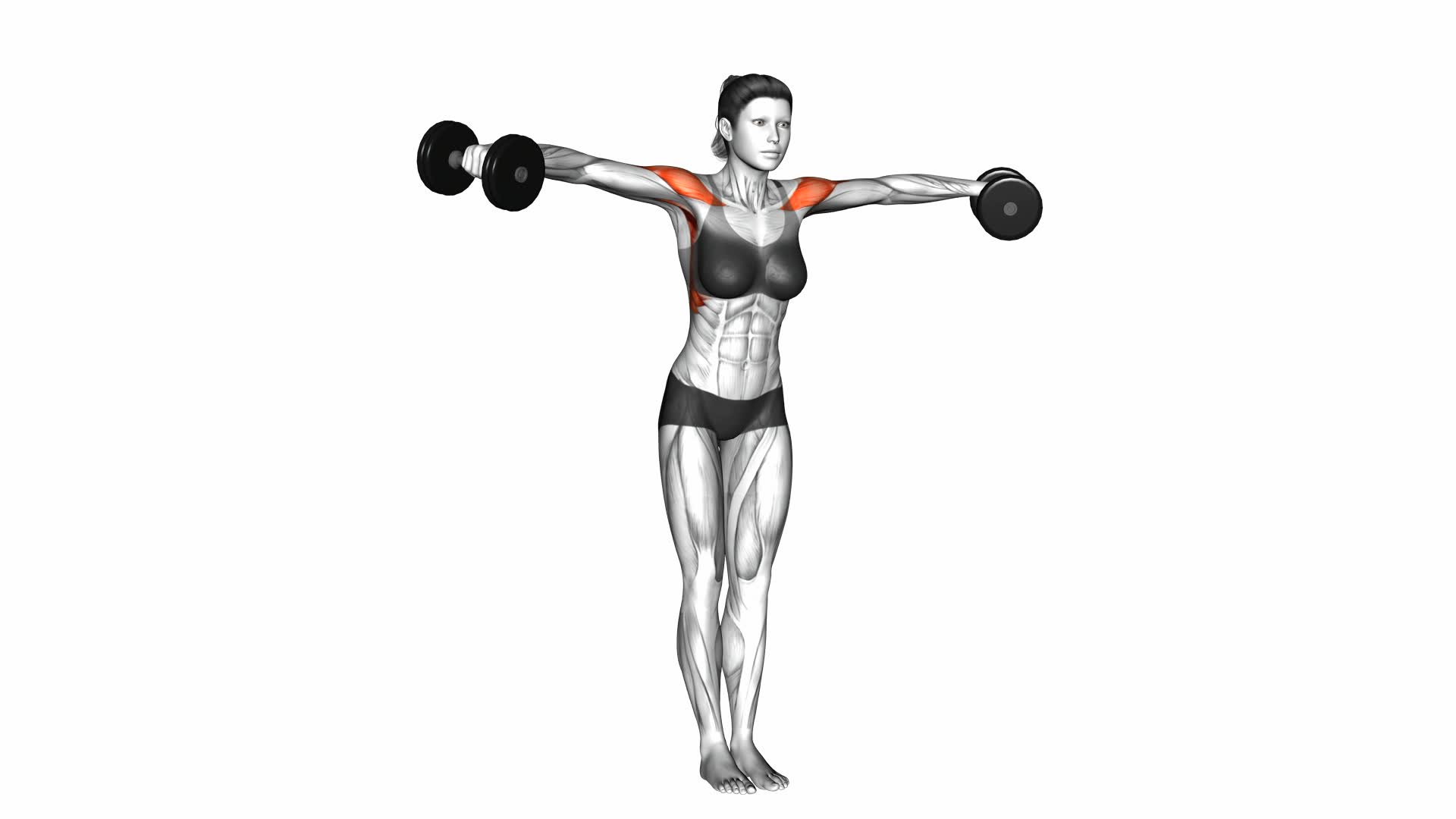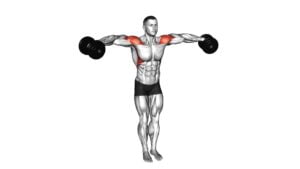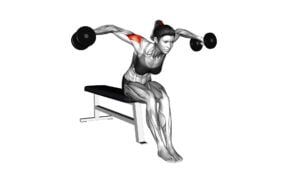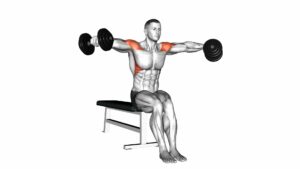Dumbbell Standing Bent Arm Lateral Raise (Female) – Video Exercise Guide & Tips

Are you looking to strengthen and tone your shoulders?
Watch This Exercise Video
Then the dumbbell standing bent arm lateral raise is the perfect exercise for you.
In this video exercise guide, we'll show you the proper form and technique to maximize muscle activation.
You'll also learn how to choose the right weight for your fitness level and avoid common mistakes.
Get ready to level up your shoulder workout with this effective move.
Let's dive in!
Key Takeaways
- Maintain a slight bend in your arms throughout the exercise
- Stand with feet shoulder-width apart and engage core
- Lift arms out to the sides, slightly bent at the elbows
- Avoid common mistakes such as using too much weight or neglecting shoulder engagement
Proper Form for Dumbbell Standing Bent Arm Lateral Raise
To perform the dumbbell standing bent arm lateral raise correctly, focus on maintaining a slight bend in your arms throughout the exercise. This is crucial for maximizing shoulder development and avoiding shoulder injuries.
Start by standing with your feet shoulder-width apart and holding a dumbbell in each hand, palms facing inwards. Keep your core engaged and your back straight throughout the movement.
Begin by lifting your arms out to the sides, keeping them slightly bent at the elbows. Raise the dumbbells until your arms are parallel to the floor, being careful not to lift them above shoulder level.
Pause for a moment at the top of the movement, then slowly lower the dumbbells back to the starting position. Remember to control the motion and avoid using momentum to lift the weights.
By maintaining a slight bend in your arms, you engage the muscles in your shoulders more effectively, leading to better results and reducing the risk of injury.
Now that you know the proper form for this exercise, let's move on to choosing the right weight for your fitness level.
Choosing the Right Weight for Your Fitness Level
Are you unsure of how to choose the right weight for your fitness level when performing the dumbbell standing bent arm lateral raise? Selecting the appropriate weight is crucial for maximizing the benefits of this exercise and avoiding injury.
Here are some tips to help you with weight selection and progression strategies:
- Start with a light weight: Begin with a weight that you can comfortably lift for 10-12 repetitions with proper form. This will allow you to focus on technique and build a foundation.
- Gradually increase the weight: As you become stronger and more comfortable with the exercise, gradually increase the weight in small increments. Aim for a weight that challenges you, but still allows you to complete the desired number of repetitions with good form.
- Listen to your body: Pay attention to how your muscles feel during and after each set. If the weight feels too easy, it may be time to increase it. Conversely, if you're struggling to maintain proper form, consider decreasing the weight.
- Progress at your own pace: Everyone's fitness level is different, so it's important to progress at a pace that's suitable for you. Don't compare yourself to others and focus on your own progress.
Step-by-Step Instructions for Performing the Exercise
To perform the dumbbell standing bent arm lateral raise exercise, follow these step-by-step instructions.
Start by standing with your feet shoulder-width apart, holding a dumbbell in each hand with your palms facing your body. Engage your core and keep your back straight throughout the exercise.
Bend your elbows slightly and lift your arms out to the sides until they're parallel to the floor, forming a 'T' shape with your body. Keep a slight bend in your elbows as you raise your arms.
Pause for a second at the top of the movement, then slowly lower the dumbbells back to the starting position. Repeat for the desired number of repetitions.
Proper technique is essential when performing the dumbbell standing bent arm lateral raise. It's important to maintain control throughout the movement and avoid using momentum to swing the weights up.
Focus on using your shoulder muscles to lift the dumbbells, rather than relying on your arms or back. This exercise helps to strengthen and tone the deltoid muscles in your shoulders, leading to improved upper body strength and posture.
As you transition into the next section about common mistakes to avoid while doing bent arm lateral raises, remember to stay mindful of your form and technique to maximize the benefits of this exercise.
Common Mistakes to Avoid While Doing Bent Arm Lateral Raises
While performing the dumbbell standing bent arm lateral raise, it's important to be aware of common mistakes to avoid. These mistakes can hinder your progress and potentially lead to injury.
To ensure you're getting the most out of this exercise and engaging your shoulders correctly, here are some common mistakes to watch out for:
- Using too much weight: It's essential to choose a weight that challenges you without compromising your form. Using excessive weight can cause you to swing your body and decrease the effectiveness of the exercise.
- Lifting the dumbbells too high: Raising the dumbbells above shoulder level can put unnecessary strain on your rotator cuff and increase the risk of injury. Focus on lifting the weights to a comfortable height parallel to your shoulders.
- Leaning forward or backward: Maintaining proper posture is crucial during this exercise. Avoid leaning forward or backward as it shifts the focus away from your shoulders and places strain on your lower back.
- Neglecting shoulder engagement: The primary goal of the bent arm lateral raise is to target the shoulder muscles. Make sure to actively engage your shoulders throughout the movement, rather than relying on momentum or other muscle groups.
Tips for Maximizing Shoulder Engagement and Muscle Activation
To maximize shoulder engagement and muscle activation during the dumbbell standing bent arm lateral raise, it's important to focus on proper form. Keep your core engaged, maintain a slight bend in your elbows, and avoid using momentum to lift the weights.
To target specific muscles, try adjusting your hand position or using different grip variations.
For added challenge, you can increase the weight, perform the exercise on an unstable surface, or incorporate other resistance training techniques.
Proper Form Importance
How can you maximize shoulder engagement and muscle activation during the Dumbbell Standing Bent Arm Lateral Raise (Female) exercise?
Proper form is crucial for reaping the benefits of this exercise. Here are some tips to help you optimize your shoulder engagement and muscle activation:
- Stand with your feet shoulder-width apart and maintain a slight bend in your knees.
- Keep your core engaged and your back straight throughout the movement.
- Hold the dumbbells with a firm grip, keeping your wrists neutral.
- As you raise your arms out to the sides, make sure to lead with your elbows and focus on squeezing your shoulder blades together.
By following these guidelines, you can ensure that your shoulders are fully engaged and the targeted muscles are activated during the exercise.
Now, let's move on to targeting specific muscles.
Targeting Specific Muscles
To effectively target specific muscles and maximize shoulder engagement and muscle activation during the Dumbbell Standing Bent Arm Lateral Raise (Female) exercise, focus on controlling the movement and maintaining proper form. By doing so, you can maximize shoulder strength and reap the benefits of lateral raises.
To engage your shoulders effectively, start by standing tall with your feet shoulder-width apart and a dumbbell in each hand. Keep a slight bend in your elbows throughout the exercise. As you raise your arms out to the sides, focus on squeezing your shoulder blades together and lifting with your shoulders, rather than using momentum or swinging the weights. This controlled movement ensures that your shoulder muscles are doing the work, leading to better muscle activation and strengthening.
Maintaining proper form is crucial for targeting the specific muscles involved in this exercise. Keep your core engaged and your back straight throughout the movement. Avoid lifting the dumbbells too high, as this can put unnecessary strain on your neck and trap muscles. Instead, aim to lift your arms to shoulder height, keeping a slight bend in your elbows. This will help maximize shoulder engagement and prevent injury.
Variations for Added Challenge
To further challenge yourself and maximize shoulder engagement and muscle activation, try incorporating variations of the Dumbbell Standing Bent Arm Lateral Raise (Female) exercise.
Here are some advanced shoulder exercises that can increase the difficulty and take your workout to the next level:
- Single-arm Dumbbell Standing Bent Arm Lateral Raise: Perform the exercise with one arm at a time, focusing on maintaining proper form and control throughout the movement. This variation will require greater stability and coordination.
- Dumbbell Standing Bent Arm Lateral Raise with Resistance Bands: Attach resistance bands to your wrists or elbows and perform the exercise with the added resistance. This will increase the challenge and provide a different type of resistance throughout the movement.
- Dumbbell Standing Bent Arm Lateral Raise with Isometric Holds: Pause at the top of each repetition and hold the weight for a few seconds before lowering it back down. This will increase time under tension and further engage the shoulder muscles.
- Dumbbell Standing Bent Arm Lateral Raise with an Elevated Surface: Stand on an elevated surface like a step or a bench while performing the exercise. This will increase the range of motion and engage the shoulder muscles more effectively.
Incorporating these variations into your workout routine won't only challenge your shoulder muscles but also help you achieve better overall strength and muscle activation.
Incorporating the Dumbbell Standing Bent Arm Lateral Raise Into Your Workout Routine
To incorporate the dumbbell standing bent arm lateral raise into your workout routine, it's important to focus on efficiency and proper form. This exercise is an effective way to target your shoulder muscles, so make sure you're using the correct technique to maximize muscle engagement.
Additionally, you can vary the exercise by adjusting the weight, tempo, or range of motion to target different areas of your shoulders.
Efficient Shoulder Workout
Incorporate the dumbbell standing bent arm lateral raise into your workout routine for an efficient shoulder workout. This exercise specifically targets the shoulder muscles, helping you build strength and definition in that area. Here are four reasons why this exercise is beneficial for your shoulder workouts:
- Targets multiple shoulder muscles: The dumbbell standing bent arm lateral raise engages the deltoids, traps, and rotator cuff muscles, providing a comprehensive shoulder workout.
- Improves shoulder stability: By strengthening the muscles surrounding your shoulder joint, this exercise enhances stability and reduces the risk of injuries.
- Enhances posture: Strong shoulder muscles help improve your posture, preventing common issues like rounded shoulders.
- Increases upper body strength: Regularly incorporating this exercise into your routine will lead to increased upper body strength and overall fitness.
Proper Form Importance
Ensure you perform the dumbbell standing bent arm lateral raise with proper form to maximize its effectiveness in your workout routine. Proper form is essential for maximizing results and preventing injuries.
To perform the exercise correctly, stand with your feet shoulder-width apart and hold a dumbbell in each hand, palms facing inward. Keep your back straight and engage your core. Bend your elbows slightly and lift your arms out to the sides until they're parallel to the floor. Avoid swinging or using momentum to lift the weights. Control the movement and focus on engaging your shoulder muscles. Remember to exhale as you lift the dumbbells and inhale as you lower them.
By maintaining proper form, you'll ensure that you're targeting the correct muscles and avoiding unnecessary strain.
Now, let's move on to the next section about variations for muscle targeting.
Variations for Muscle Targeting
Now let's explore how you can incorporate the dumbbell standing bent arm lateral raise into your workout routine to target different muscles. Here are some variations you can try:
- Front Raise: Instead of raising your arms to the sides, raise them to the front. This targets the front deltoids and upper chest muscles.
- Lateral Raise with External Rotation: As you lift your arms to the sides, rotate your palms so they face forward. This engages the rotator cuff muscles, providing stability and strengthening the shoulder joint.
- Overhead Press: Start with the dumbbells at shoulder level, then press them overhead. This variation targets the entire shoulder complex, including the deltoids, trapezius, and upper back muscles.
- Supine Lateral Raise: Lie on your back and lift the dumbbells to the sides. This variation engages the core muscles and works the shoulders from a different angle.
Frequently Asked Questions
How Many Sets and Reps Should I Do for the Dumbbell Standing Bent Arm Lateral Raise?
To get the most out of the dumbbell standing bent arm lateral raise, it's important to know how many sets and reps to do.
For this exercise, a good starting point is 3 sets of 10-12 reps. However, you can adjust the numbers based on your fitness level and goals.
If you don't have dumbbells, you can also use resistance bands or even water bottles as alternatives.
Remember to start with lighter weights and gradually increase as you get stronger.
Can I Use Resistance Bands Instead of Dumbbells for This Exercise?
Yes, you can use resistance bands instead of dumbbells for this exercise.
Using resistance bands offers several benefits for strength training. They provide variable resistance throughout the movement, targeting your muscles in a different way.
Resistance bands also allow you to increase or decrease the resistance level by adjusting the tension. This can help you progress and challenge your muscles as you get stronger.
Is It Okay to Feel a Slight Discomfort or Burn in the Shoulders During the Exercise?
Should I use lighter weights for the dumbbell standing bent arm lateral raise if I feel discomfort in my shoulders?
Is it normal to feel a burn in my shoulders during the dumbbell standing bent arm lateral raise exercise?
It's important to listen to your body during any exercise.
If you're experiencing discomfort or a burn in your shoulders, it may indicate that the weight you're using is too heavy.
Consider using lighter weights to reduce strain on your shoulders and prevent injury.
Should I Perform This Exercise at the Beginning or End of My Workout Routine?
Should I perform this exercise before or after cardio?
It's generally recommended to perform strength training exercises, like the dumbbell standing bent arm lateral raise, before cardio. This allows you to have more energy and focus for your strength exercises. Additionally, performing strength exercises before cardio can help to warm up the muscles and prepare them for the cardio workout.
However, it ultimately depends on your personal preference and goals.
Are There Any Modifications or Variations of the Dumbbell Standing Bent Arm Lateral Raise for Beginners or Advanced Lifters?
When it comes to the dumbbell standing bent arm lateral raise, there are indeed modifications for beginners and variations for advanced lifters.
Beginners can start with lighter weights or even use resistance bands to reduce the intensity.
As for advanced lifters, they can increase the weight used or perform the exercise on an unstable surface like a Bosu ball to challenge their stability and engage more muscles.
These modifications and variations can help you tailor the exercise to your fitness level.
Conclusion
Incorporating the dumbbell standing bent arm lateral raise into your workout routine can help maximize shoulder engagement and muscle activation. By following proper form, choosing the right weight, and avoiding common mistakes, you can effectively target your shoulder muscles.
This exercise is a great addition to any fitness routine and can help improve upper body strength and stability.

Author
Years ago, the spark of my life’s passion ignited in my mind the moment I stepped into the local gym for the first time. The inaugural bead of perspiration, the initial endeavor, the very first surge of endorphins, and a sense of pride that washed over me post-workout marked the beginning of my deep-seated interest in strength sports, fitness, and sports nutrition. This very curiosity blossomed rapidly into a profound fascination, propelling me to earn a Master’s degree in Physical Education from the Academy of Physical Education in Krakow, followed by a Sports Manager diploma from the Jagiellonian University. My journey of growth led me to gain more specialized qualifications, such as being a certified personal trainer with a focus on sports dietetics, a lifeguard, and an instructor for wellness and corrective gymnastics. Theoretical knowledge paired seamlessly with practical experience, reinforcing my belief that the transformation of individuals under my guidance was also a reflection of my personal growth. This belief holds true even today. Each day, I strive to push the boundaries and explore new realms. These realms gently elevate me to greater heights. The unique combination of passion for my field and the continuous quest for growth fuels my drive to break new ground.







